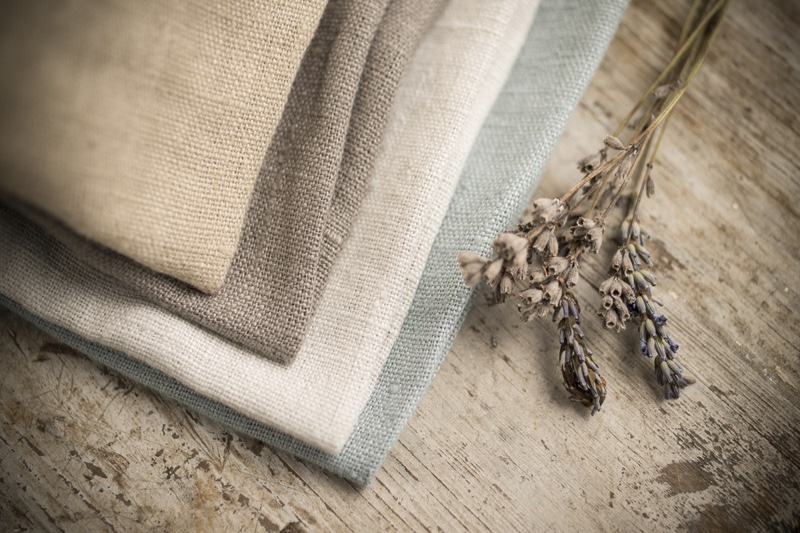
Linen usage goes back thousands of years. In fact, in Ancient Egypt, it was highly valued that it was used as currency. Did they covet this material due to linen sustainability or perhaps was it something else? Did they see something in this fabric that we are unaware of?
Ghada Al-Shaikh, owner of sustainable linen clothing brand G Linen World, explains why linen is a healthy and eco-friendly fabric to wear.
How is Linen Sustainable?
Linen is made from bast fiber. It is created from the fibers of a blue-flowered flax plant.
Flax has created fiber for thousands of years and can be found on a global scale. Spiritually and culturally, anthropological studies indicate it has been used for almost 36,000 years.
From the Planting and Harvesting Process…
Flax takes 100 days from planting to harvest compared to cotton (150-180 days). This makes it the second-highest productive fiber crop. Linen is locally grown with Belgium being renown for the leader for quality flax. Russia is the largest producer of it, farms produce it throughout the United States and Asia.
Flax flourishes with little rainwater and humidity. Farmers do not have to irrigate their crops eliminating excessive water consumption. This makes it easy on the earth and a sustainable product.
To put it into perspective, only 6.4 liters of water are required to make a linen shirt versus 2,700 liters for a cotton shirt. In terms of potential drinking water, cotton shirts take up about three years’ worth of drinking water just to produce one shirt.
Furthermore, flax uses fewer to no pesticides or insecticides. The fiber is strong and doesn’t require much to promote growth. It also returns nutrients back to the soil by being biodegradable. While cotton, in comparison, consumes 11% of pesticide sales and 24% of insecticide sales.
The reason why flax requires fewer pesticides and insecticides is that insects aren’t their natural enemy. The field mouse is the only animal that can damage a flax crop. It doesn’t require fertilizers or irrigation to grow. This makes it the second most sustainable product in terms of natural fabric.
Flax is also easy on the land. It incorporates easily into crop rotation cycles thereby preventing soil depletion.

To the Production Process is Sustainable
Even the production process has sustainable benefits. Retting of flax fibers involves placing the cut plant on the ground. Moisture separates the fibers used for weaving. Once finished, the threads are woven using traditional hand looms.
Even though there are improvements in flax production, ancient methods are still incorporated. This method is eco-friendly and uses fewer chemicals.
Produces No Waste
Flax produces no waste. All parts of the plants are used to make different products. For example, the seeds are used to create linseed oil, and flax seeds are used as food. Pure linen that is undyed and unfinished can undergo further decomposition by composting. It’s safe for the environment, recyclable, and biodegradable.

Why Choose Linen for Clothing?
Linen is a natural fiber, making it lightweight, breathable, and comfortable to wear. Linen removes perspiration away from the body on hot, humid days, and is an insulator on the coldest seasons.
Moisture Wicking Properties
Linen regulates body temperature through a skin-to-air heat exchange. This means that if the weather is hot or humid, the material will draw moisture into the fabric and away from the body. The body is left cool and dry as opposed to hot and sticky. It also evaporates quickly.
People wearing linen will perspire 1.5 times less than those wearing cotton, and twice less than while wearing viscose clothing.
Regulates Body Temperature
Since linen wicks away perspiration easily, it is easy to see how it regulates body temperature during hot seasons, and why it is beneficial in tropical climates. However, what about when temperatures drop?
When temperatures drop, linen helps to regulate body temperature. Linen’s heat conductivity is five times higher due to its high thermal insulation properties. So, when it is cold, linen will save the body’s heat. Linen has temperature regulating properties.

Designed to Last
Linen is 30% stronger than conventional cotton fiber. Their fibers are long, strong, and durable. In fact, while most fabrics break apart after repeated washings, linen only becomes softer.
Since linen is stronger when wet than dry, the more it is washed, the softer it becomes. Therefore, it is more durable than other fabrics and lasts longer. The danger of repeated washing is it breaks down the natural fiber over time. They become weak and lead to stretching. Linen doesn’t have this issue.
Linen also resists moths damaging when items are stored and kills bacteria as no fungus can survive on it. Ancient civilizations capitalized on this feature, and linen was used for bandages as the skin healed better. It was also known to decrease inflammation.
Colors Won’t Fade
Linen is naturally produced in a range of colors from ivory to taupe. This means that less water is used, and harsh chemicals have not been used to make the linen garment. For some colors, dye is used on flax, so be sure that it is done in a responsible facility.
Meanwhile, other fabrics can use 75% of dye to make sure it is colorfast and washed repeatedly in hot water. It is responsible for 20% of industrial water pollution and volumes of wastewater.
Clothing Gives Back to Nature
Linen is a durable product. However, when it does break apart, the fabric is biodegradable and recyclable. Linen can be composted back into the environment and reused. Most other clothing just takes up space in a landfill.
Choosing Linen is Choosing to be Sustainable
Ethical linen clothing can accommodate hot, humid climates, and is eco-friendly. Many linen collections are designed for stylish dress but can also maintain a woman’s modesty as well.
Linen garments are perfect for people who are conscious of the sustainability of the products they purchase. Linen is a sustainable material and is gentle on the earth. From harvesting to production, the entire plant is used leaving nothing behind.
It doesn’t use a great deal of water for irrigation as it doesn’t require it, and uses few, if any, chemicals.
In terms of clothing, it is strong and will last a long time. When it is done, it can then be recycled back into the earth.





